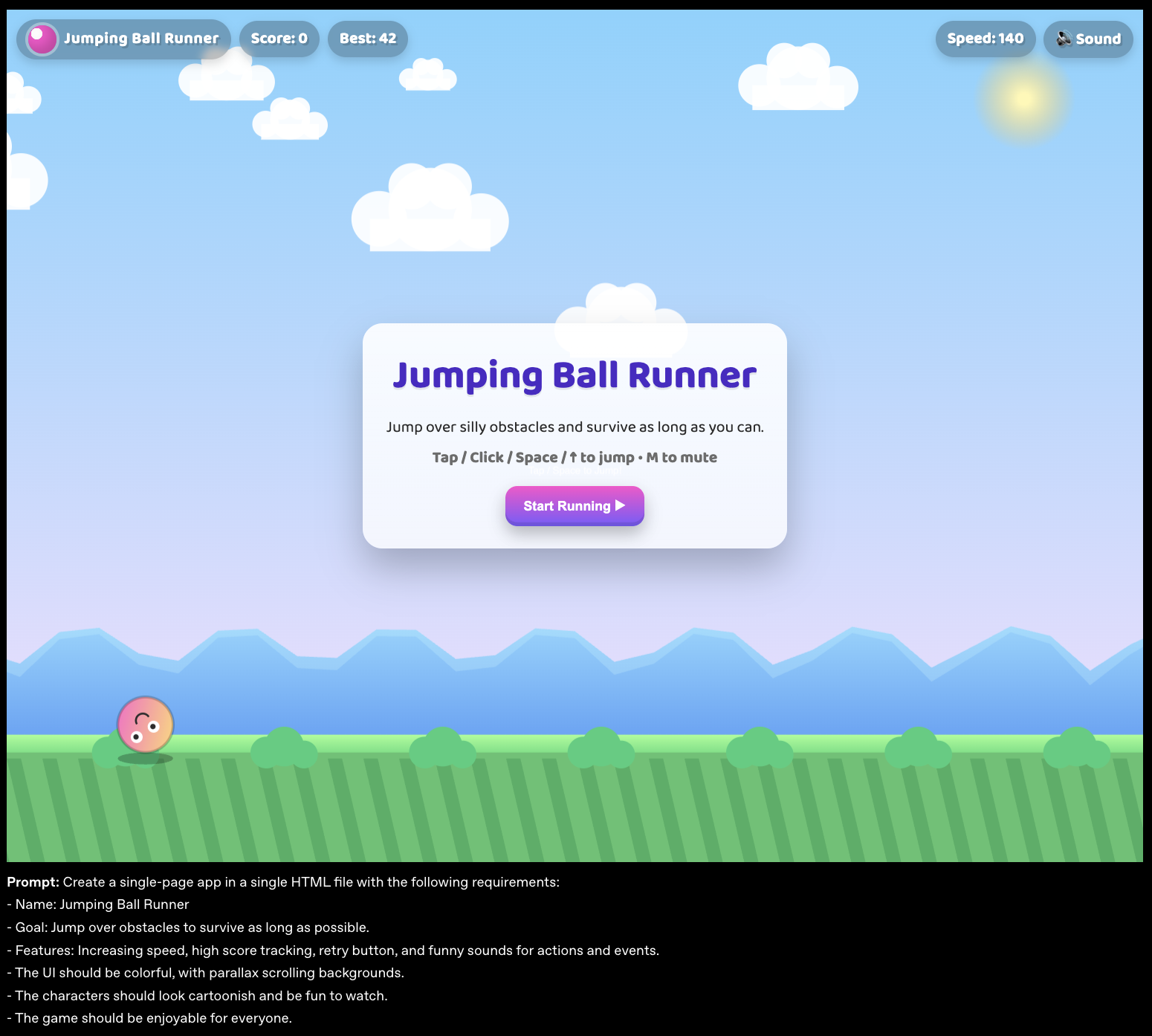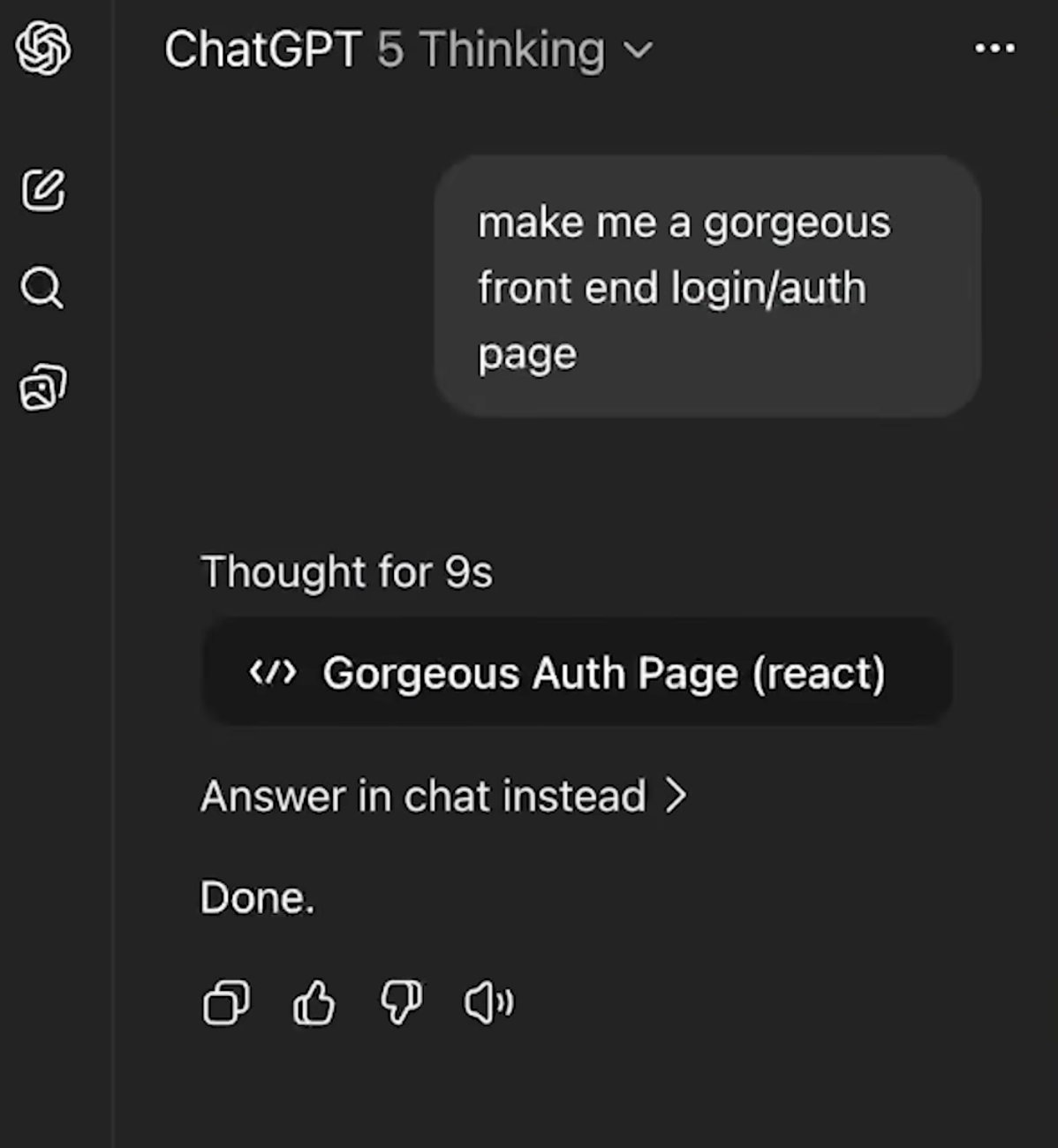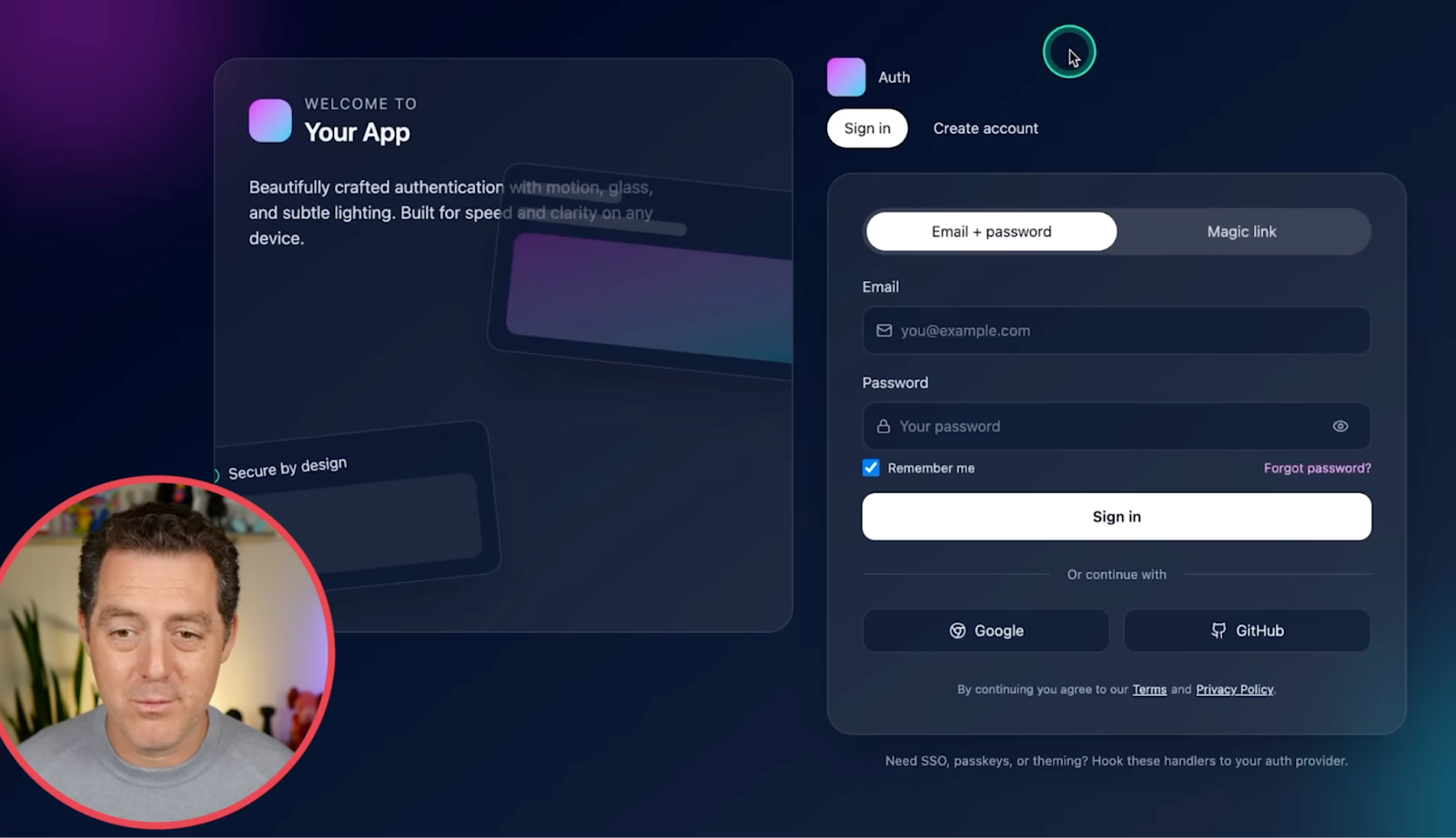Okay, so I’m getting straight to the point: GPT-5 is insane. Now I’m no AI/ML expert, but as a content marketer, I’ve had generative models baked into my daily workflow. Funny enough, back in my sophomore year of college, right after ChatGPT first came out for public use, I took an elective called Creativity With AI. Chat was super cool and fascinating then, but it wasn’t this.
Fast-forward to this morning, GPT‑5 is generating full front-end landing pages from a single prompt. GPT‑5 doesn’t just respond faster, it reasons, adapts, and creates in a way that feels more like a plugged-in creative partner than a chatbot. The leap is obvious: this model moves differently. We’re not in version bump territory anymore. We’re standing at a new baseline for how people and machines collaborate. Let’s dig into what makes it so different.
The GPT‑5 Rollout
OpenAI flipped the switch on August 7, 2025 and introduced three public variants of the newly introduced GPT-5: GPT-5 Mini for speed, GPT-5 Standard for everyday use, and GPT-5 Pro for the deepest reasoning. Every prompt first meets a lightweight “quick brain”; if that brain smells complexity, it escalates to GPT-5 Thinking, which can even show its chain of thought on request. The experience feels simultaneously faster and smarter, as though you’re chatting with a Professor in academia who’s happy to show their work.
What Can GPT 5 Do?
Not only is it cool, but it’s a foundational shift beyond a typical upgrade, delivering faster, more context-aware, and reliable responses. ChatGPT-5 intelligently balances speed and depth by dynamically deciding whether a prompt needs quick answers or deeper reasoning, learning from user behavior over time. When usage limits are hit, a lightweight “mini” version takes over to maintain continuity. GPT-5 is notably better at following directions, avoids excessive agreeableness, and makes fewer factual errors. These advancements are especially impactful in writing, coding, and health, domains where clarity, precision, and adaptability are critical.
Coding
GPT‑5 can generate working websites, apps, and games from a single prompt. Its design instincts have improved too, with cleaner spacing, better layout, and more aesthetic awareness. It’s stronger at debugging and can handle larger codebases, making it a serious tool for marketers building interactive assets. Check out OpenAI’s official intro for developers here for the full breakdown.

Health
GPT‑5 performs significantly better on medical queries than any previous model. It acts more like a thought partner, asking follow-up questions, flagging risks, and customizing answers to your location and knowledge level. It doesn’t replace a doctor, but it’s a great tool to prepare for appointments or make sense of test results. You can see more on health performance here.
Performance & Benchmarks
GPT‑5 is also significantly smarter across the board. It solves nearly 95% of AIME 2025 math problems, crushes real-world bug-fix challenges on SWE-Bench, and now “sees” images and video with accuracy that rivals a sharp-eyed intern. OpenAI also retrained the safety layer, so instead of shutting down tricky prompts, the model now leans toward partial, context-aware responses. Hallucinations, which are confident but incorrect AI responses, are down around 45%, it’s half as likely to fake confidence on deception tests, and thanks to leaner token use, the cost per accurate answer has dropped.
In plain English: GPT-5 nails tough math, squashes stubborn software bugs, and watches video like a bright junior hire. It gives helpful answers instead, makes half as many blunders, and works more efficiently, so every accurate response is cheaper, too.
If you’re hungry for more detail (and who isn’t?), check out OpenAI’s official GPT‑5 introduction instead:
GPT‑5: Your Creative Department’s New Secret Weapon
Imagine brainstorming twenty subject-line options before your coffee gets cold, then asking the same model to turn the favored line into an Instagram reel, a LinkedIn intro, and a Spanish push Facebook announcement, each tuned to platform quirks without losing brand voice. Need a newsletter landing page? Provide GPT-5 Pro with a one-sentence brief and it will generate polished copy, responsive HTML, and a follow-up email sequence in a single volley. Drop in a screenshot of a competitor’s Instagram Reel and GPT-5 will dissect the palette, typography, and pacing so you can reverse-engineer the magic. Because hallucinations are rarer, compliance spends fewer late nights red-lining passages, and the new safe-completion style means regulated verticals finally get usable copy instead of a brick wall. When I tell you GPT-5 is insane, I actually mean it.
If you want the nerdy deep dive into when to choose which model for what, our agency founder just published “A Practical Guide to Frontier AI for Marketing Executives.” Read that after you finish here.
Why Creatives Should Care
GPT‑5 isn’t just a tool for developers, it’s a breakthrough for anyone tasked with driving growth, campaigns, or content. In early use, marketers have prompted it to build polished landing pages and microsites from plain English descriptions, no hand-coding, no templates, just fast, usable output. That means creative teams spend less time wrangling HTML and more time iterating on strategy, copy, and design. Analysts have watched it digest massive data sets and instantly surface trends, stitching together customer journeys that once took hours of spreadsheet wrangling. And with hallucination rates dropping by as much as 80%, trust is growing. Teams feel safer leaning into AI-driven workflows without the usual anxiety over brand risk or factual blunders.


Most impressively, the model can leap straight from idea to execution by spinning up interactive tools, or even entire no-code web apps, from a single prompt, teeing us up perfectly for the code-quality glow-up you’ll see in the next section.

A quick side-by-side tells the story. GPT-4 mini-high’s Pokémon-chess board landed as a blurry, repetitive grid with missing squares and duplicate sprites, clearly a proof-of-concept at best. Feed the identical prompt to GPT-5 and you get a crisp, balanced 8 × 8 layout, unique pieces in every slot, and polished assets that could ship to production with minimal touch-up. That fidelity and the speed at which it’s delivered is exactly why dev-heavy creative marketing teams, or anyone prototyping interactive content, should be paying close attention.
Personalization gets a lift too. GPT-5 now supports built-in “personalities” that embed brand tone into every response, so customer-facing comms stay consistent across chatbots, emails, and social replies. For creative marketers, it’s a helpful layer for creative thinking or voice matching, but when it comes to actual outputs like persona drafts, landing pages, or campaign copy, your instructions take priority. Even with a playful personality selected, ChatGPT will stick to your brief unless you tell it otherwise.
For tips on treating AI like a diligent intern check out our take here.
Limitations You Still Need to Respect
GPT-5 is not artificial general intelligence. It can misinterpret messy prompts, slip into cliché, or lose context in marathon chats. Free-tier users already see capacity banners during peak hours, so expect to pony up for Plus or Pro if you want friction-free access. Machine prose can drift toward the generic, meaning first drafts still need a human polish. And while early testers swear the model remembers more of a long conversation, OpenAI hasn’t published formal context-window specs.
What It Costs and How to Get In
Everyone with a ChatGPT account can poke at GPT-5 today, but the free tier limits how many rich conversations you can have before the system falls back to GPT-5 Mini. The twenty-dollar Plus plan raises those caps and keeps you on the Standard model most of the day. The two-hundred-dollar Pro plan removes usage limits entirely and unlocks GPT-5 Pro for heavyweight tasks. Team and Enterprise customers negotiate custom contracts that add admin controls and uptime guarantees. If the GPT-5 tab isn’t visible yet, refresh later, or upgrade and stroll past the velvet rope.
GPT‑5: In a Nutshell
Want the TL;DR? We’ve got you. Below are quick answers to the most common questions we’ve seen flying around about GPT‑5, what it is, what it costs, how to access it, and why it matters.
Is ChatGPT 5 available?
Yes. OpenAI began the global rollout on August 7th, 2025, and is enabling the model for every account over the next few days.
How much better is ChatGPT-5 than 4?
Early benchmarks show 2–3× fewer hallucinations, major coding-task gains, and sharper image- & video-reasoning compared with GPT-4.
What will ChatGPT-5 be able to do?
Expect steadier answers over very long conversations, stronger multimodal reasoning, and faster code generation. Be mindful that although referred to as a PhD-level partner-in-crime, OpenAI stresses it still falls short of true AGI-level intelligence.
How can I access ChatGPT 5?
Sign in on the ChatGPT website or mobile apps. Free-tier users get a small daily allotment of GPT-5 requests; Plus and Pro subscribers see almost no throttling.
How much will ChatGPT-5 cost?
GPT-5 is free for everyone in ChatGPT, but power users can upgrade. ChatGPT Plus ($200/month) unlocks unlimited GPT-5 and GPT-5 Pro access, while Team and Enterprise plans add shared workspaces and admin tools for organizations.
Will ChatGPT-5 be AGI?
No. OpenAI’s leadership calls GPT-5 “a significant fraction of the way” toward human-level intelligence, but they are clear that it still falls short of true artificial general intelligence.
Will ChatGPT-5 have more memory?
OpenAI hasn’t released official context-window numbers. Early testers do report noticeably stronger long-conversation recall, but until specs are published we only know that GPT-5 is more efficient rather than definitively “larger” in memory.
Will ChatGPT-5 replace programmers?
Unlikely. GPT-5 can scaffold apps, fix bugs, and generate front-end code far faster than GPT-4, yet it still needs human developers to write nuanced business logic, set architecture, review security, and decide what to build in the first place. It’s here to accelerate your work, not replace the craftspeople. So yes, programmers can exhale.
Now Go Make Cool Stuff
In short, GPT-5 really is the next big thing in AI, redefining how we interact with intelligent systems across domains. From front-end coding to theoretical physics, from brainstorming marketing copy to exploring complex health questions (with the important caveat that it’s not a licensed medical professional), GPT-5 doesn’t just perform tasks, it adapts, reasons, and responds with unprecedented nuance and speed. Its ability to shift seamlessly between quick answers and deep analysis makes it feel more like a thinking partner than a tool. Whether you're debugging code, analyzing data, writing essays, or just trying to learn something new, GPT-5 isn’t just more powerful, it’s more helpful, more human, and more aligned with how we think and work.
Now onward! Go have fun out there and create awesome things. :)






